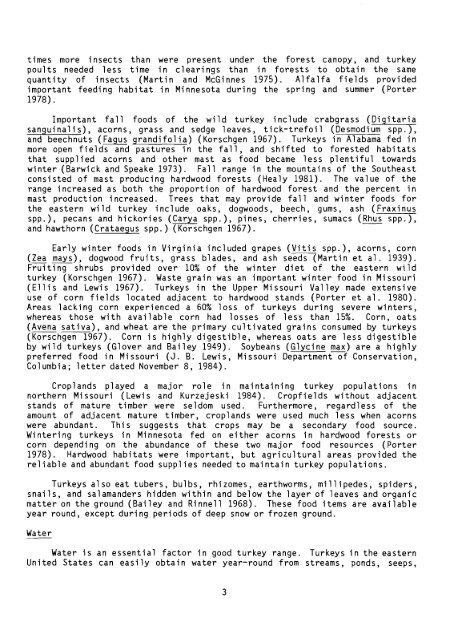habitat suitability index models: eastern wild turkey - USGS National ...
habitat suitability index models: eastern wild turkey - USGS National ...
habitat suitability index models: eastern wild turkey - USGS National ...
Create successful ePaper yourself
Turn your PDF publications into a flip-book with our unique Google optimized e-Paper software.
times more insects than were present under the forest canopy, and <strong>turkey</strong><br />
poults needed less time in clearings than in forests to obtain the same<br />
quantity of insects (Martin and McGinnes 1975). Alfalfa fields provided<br />
important feeding <strong>habitat</strong> in Minnesota during the spring and summer (Porter<br />
1978).<br />
Important fall foods of the <strong>wild</strong> <strong>turkey</strong> include crabgrass (Digitaria<br />
sanguinalis), acorns, grass and sedge leaves, tick-trefoil (Desmodium spp.),<br />
and beechnuts (Fagus grandifolia) (Korschgen 1967). Turkeys in Alabama fed in<br />
more open fi e1ds and pastures in the fall, and shi fted to forested habi tats<br />
that supplied acorns and other mast as food became less plentiful towards<br />
winter (Barwick and Speake 1973). Fall range in the mountains of the Southeast<br />
consisted of mast producing hardwood forests (Healy 1981). The value of the<br />
range increased as both the proportion of hardwood forest and the percent in<br />
mast production increased. Trees that may provide fall and winter foods for<br />
the <strong>eastern</strong> <strong>wild</strong> <strong>turkey</strong> include oaks, dogwoods, beech, gums, ash (Fraxinus<br />
spp.), pecans and hickories (Carya spp.), pines, cherries, sumacs (Rhus spp.),<br />
and hawthorn (Crataegus spp.) (Korschgen 1967). ----<br />
Early winter foods in Virginia included grapes (Vitis spp.), acorns, corn<br />
(Zea mays), dogwood fruits, grass blades, and ash seeds (Martin et al. 1939).<br />
Frui t i ng shrubs provi ded over 10% of the wi nter di et of the <strong>eastern</strong> wi 1d<br />
<strong>turkey</strong> (Korschgen 1967). Waste grain was an important winter food in Missouri<br />
(Ellis and Lewis 1967). Turkeys in the Upper Missouri Valley made extensive<br />
use of corn fields located adjacent to hardwood stands (Porter et al. 1980).<br />
Areas 1acki ng corn experi enced a 60% loss of <strong>turkey</strong>s duri ng severe wi nters,<br />
whereas those with available corn had losses of less than 15%. Corn, oats<br />
(Avena sativa), and wheat are the primary cultivated grains consumed by <strong>turkey</strong>s<br />
(Korschgen 1967). Corn is highly digestible, whereas oats are less digestible<br />
by <strong>wild</strong> <strong>turkey</strong>s (Glover and Bailey 1949). Soybeans (Glycine max) are a highly<br />
preferred food in Missouri (J. B. Lewis, Missouri Departmentof Conservation,<br />
Columbia; letter dated November 8, 1984).<br />
Croplands played a major role in maintaining <strong>turkey</strong> populations in<br />
northern Missouri (Lewis and Kurzejeski 1984). Cropfields without adjacent<br />
stands of mature timber were seldom used. Furthermore, regardless of the<br />
amount of adjacent mature timber, croplands were used much less when acorns<br />
were abundant. Thi s suggests that crops may be a secondary food source.<br />
Wi nteri ng <strong>turkey</strong>s in Mi nnesota fed on ei ther acorns in hardwood forests or<br />
corn dependi ng on the abundance of these two major food resources (Porter<br />
1978). Hardwood <strong>habitat</strong>s were important, but agricultural areas provided the<br />
reliable and abundant food supplies needed to maintain <strong>turkey</strong> populations.<br />
Turkeys also eat tubers, bulbs, rhizomes, earthworms, millipedes, spiders,<br />
snails, and salamanders hidden within and below the layer of leaves and organic<br />
matter on the ground (Bailey and Rinnell 1968). These food items are available<br />
year round, except during periods of deep snow or frozen ground.<br />
Water<br />
Water is an essential factor in good <strong>turkey</strong> range. Turkeys in the <strong>eastern</strong><br />
United States can easily obtain water year-round from streams, ponds, seeps,<br />
3

















